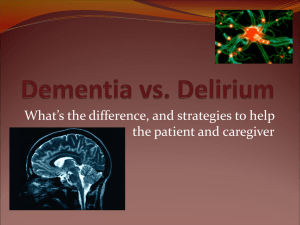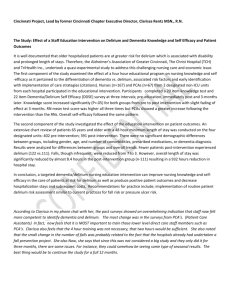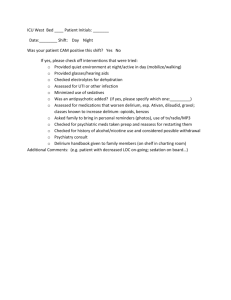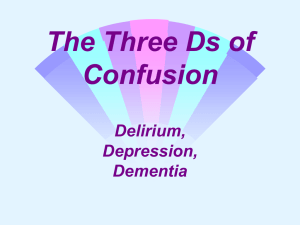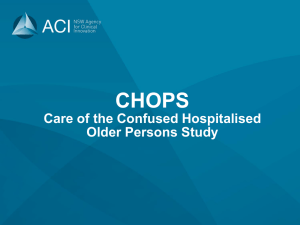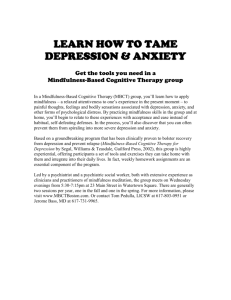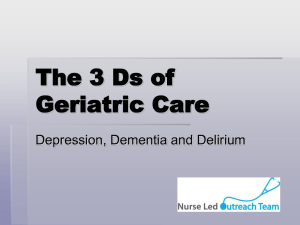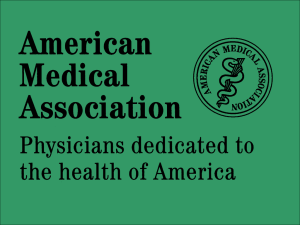Clues to Identifying Causes of Common Behavior and Psychiatric
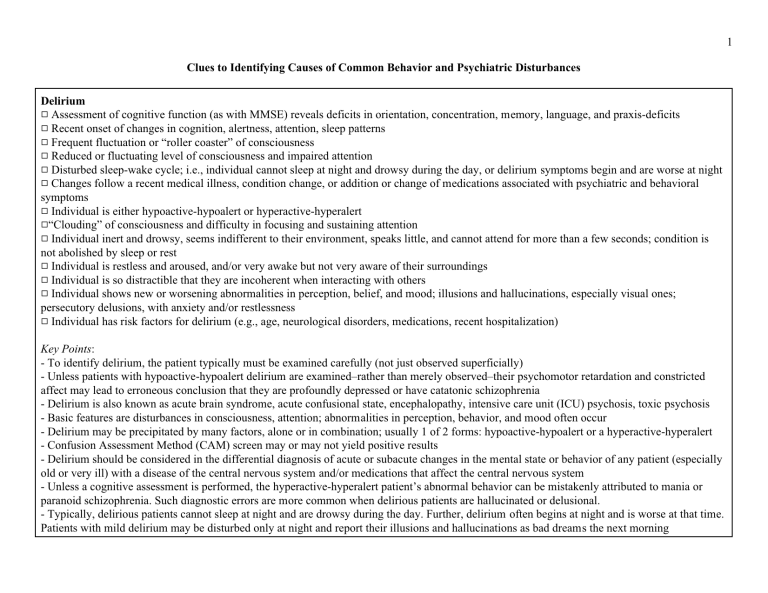
Clues to Identifying Causes of Common Behavior and Psychiatric Disturbances
Delirium
9 Assessment of cognitive function (as with MMSE) reveals deficits in orientation, concentration, memory, language, and praxis-deficits
9 Recent onset of changes in cognition, alertness, attention, sleep patterns
9 Frequent fluctuation or “roller coaster” of consciousness
9 Reduced or fluctuating level of consciousness and impaired attention
9 Disturbed sleep-wake cycle; i.e., individual cannot sleep at night and drowsy during the day, or delirium symptoms begin and are worse at night
9 Changes follow a recent medical illness, condition change, or addition or change of medications associated with psychiatric and behavioral symptoms
9 Individual is either hypoactive-hypoalert or hyperactive-hyperalert
9 “Clouding” of consciousness and difficulty in focusing and sustaining attention
9 Individual inert and drowsy, seems indifferent to their environment, speaks little, and cannot attend for more than a few seconds; condition is not abolished by sleep or rest
9 Individual is restless and aroused, and/or very awake but not very aware of their surroundings
9 Individual is so distractible that they are incoherent when interacting with others
9 Individual shows new or worsening abnormalities in perception, belief, and mood; illusions and hallucinations, especially visual ones; persecutory delusions, with anxiety and/or restlessness
9 Individual has risk factors for delirium (e.g., age, neurological disorders, medications, recent hospitalization)
Key Points :
- To identify delirium, the patient typically must be examined carefully (not just observed superficially)
- Unless patients with hypoactive-hypoalert delirium are examined–rather than merely observed–their psychomotor retardation and constricted affect may lead to erroneous conclusion that they are profoundly depressed or have catatonic schizophrenia
- Delirium is also known as acute brain syndrome, acute confusional state, encephalopathy, intensive care unit (ICU) psychosis, toxic psychosis
- Basic features are disturbances in consciousness, attention; abnormalities in perception, behavior, and mood often occur
- Delirium may be precipitated by many factors, alone or in combination; usually 1 of 2 forms: hypoactive-hypoalert or a hyperactive-hyperalert
- Confusion Assessment Method (CAM) screen may or may not yield positive results
- Delirium should be considered in the differential diagnosis of acute or subacute changes in the mental state or behavior of any patient (especially old or very ill) with a disease of the central nervous system and/or medications that affect the central nervous system
- Unless a cognitive assessment is performed, the hyperactive-hyperalert patient’s abnormal behavior can be mistakenly attributed to mania or paranoid schizophrenia. Such diagnostic errors are more common when delirious patients are hallucinated or delusional.
- Typically, delirious patients cannot sleep at night and are drowsy during the day. Further, delirium often begins at night and is worse at that time.
Patients with mild delirium may be disturbed only at night and report their illusions and hallucinations as bad dreams the next morning
1
Psychosis
9 Hallucinations, delusions, and/or thought disorder (especially, paranoid ideation)
9 Absence of prominent mood symptoms
9 No identifiable underlying medical cause
9 Escalate in intensity, frequency, duration from day to day and/or week to week
9 Not associated with fluctuating level of consciousness
9 Individual provides detailed description of disordered thoughts
Schizophrenia
9 Hallucinations, delusions, and/or thought disorder
9 Deterioration of social, occupational, and interpersonal function over time
9 Absence of prominent mood symptoms
9 Chronic persistent or recurrent course
9 Delusions are present, e.g., persecution (sometimes referred to as "paranoid delusions") or grandiose delusions without mood elevation or elation
9 Additional abnormalities of thought
9 Misinterpretations and excessive personalization of everyday situations or interactions
9 Ideas contained in sentences are not connected in a manner that can be understood in the context of usual speech
9 Mood disorders (major depression and bipolar disorder) and cognitive disorders (delirium and dementia) have been considered and ruled out
9 Any mood-related depressive delusions are self-blaming or hopeless or grandiose
Key Points
- In contrast to depression and demoralization, symptoms of schizophrenia are alien to usual human experience.
- Thought disorder can usually be distinguished from aphasia by absence of paraphasic errors, intact repetition, naming and following multistep commands, and by the presence of connecting words (absent in nonfluent aphasia) and both nouns and verbs (diminished in fluent aphasia)
2
Mania
9 Individual shows persistently elevated mood, elevated self-attitude and self-confidence, markedly increased energy and diminished need for sleep
9 Mood is labile rather than persistent
9 Self-attitude is grandiose, and/or based on delusions
9 Pressured speech and/or racing thoughts may be prominent
9 Effort made to identify and rule out a medical condition or medication known to be associated with mania
Key Points
- In mild mania (hypomania), an increase in energy makes patients more productive; in severe mania, it makes them less productive, because they are so hyperactive and distractible that they cannot complete any but the simplest task
Demoralization
9 Mood disturbance is related to the individual’s circumstances and/or an identifiable precipitant
9 The individual shows somewhat decreased responsiveness and participation
9 There is usually a chronic, progressive, painful, debilitating, or disfiguring condition
9 A sad individual who also frustrated, irritable, pessimistic, or anxious
9 There is not evidence of psychosis
9 Any delusions or hallucinations are due to another condition
9 Unpleasant emotions tend to diminish as the individual’s situation improves or when they discover that they are not powerless in the face of adversity
9 There is a more or less direct relationship between the patient's mood and his or her situation
9 Statements about possibly being “better off dead” (or similar so-called “suicidal thoughts”) are accompanied by some hopefulness about their situation and/or statement about wanting to live
9 Individual responds positively to encouragement that time will bring improvement or that new approaches might help
Key Points
- Demoralization is a normal response to adversity
- Delusions and hallucinations never occur in demoralization
- Antidepressants do not relieve normal sadness and should not ordinarily be used for such individuals, especially without trying other measures first
3
Depression
9 Delirium been considered and ruled out
9 Sad mood persists over time, rather than being intermittent or labile
9 There is diminished self-attitude and self-confidence, and a pessimistic outlook
9 There is diminished energy and impaired sleep
9 The individual lacks the capacity to enjoy events that would ordinarily bring pleasure
9 Emotions occur and persist without much relationship to the patient's situation
9 Gloomy thoughts are repeatedly and noticeably delusional in nature; i.e., based on substantial misinterpretations that the individual accepts as true
9 Mood remains low despite improving circumstances
9 Suicidal expressions are accompanied by feelings of hopelessness and guilt, with an emphasis on death as the best or only way to end the suffering
9 The individual dismisses encouragement that time will bring improvement or that new approaches might help
9 Medical conditions and/or medications that may cause significant mood disturbance have been considered and ruled out
9 Any hallucinations that are present are delusional in nature
9 There is disturbed sleep, low energy, slowed thinking and movements not attributable to other causes
9 Possible mood disorder has been distinguished from poor activity tolerance, apathy, weakness, lethargy, and reduced responsiveness
9 Cognitive function has been assessed
9 Cognitive assessment does not show significant deficits in orientation, concentration, memory, language, and praxis
9 Any of the anxiety disorders can occur secondarily with major depression. A secondary anxiety state can be recognized by its occurrence episodically only when episodes of depression occur.
Key Points
- Because neurologic diseases and their treatments can disturb sleep, appetite, energy level, psychomotor activity, and libido, abnormalities in these vital functions are by no means proof of depression
- Before insomnia, anorexia, and the like can be seen as evidence of major depression, other causes must be excluded
- When major depression is being considered as the explanation for a patient's psychomotor retardation or lack of motivation (e.g., refusal to participate in physical therapy), delirium–not depression–may often be the cause
- When an individual remains sad despite antidepressant treatment, or when they are delusional or hallucinating, or when other symptoms persist, additional thorough review and reconsideration of the diagnosis is needed
- Apathy, weakness, lethargy, reduced responsiveness are not depression, and do not respond to antidepressants
- Deficits in orientation, concentration, memory, language, and praxis-deficits are absent in affective disorders and schizophrenia
4
Anxiety
9 Individual has pervasive feelings of tension, apprehension, and worry and/or physical symptoms such as palpitations, sweating, and hyperventilation, without a clear trigger or precipitant, and/or difficulty falling asleep, mildly diminished appetite, and diminished concentration
9 These symptoms occur often enough and with enough intensity to significantly disrupt an individual’s function, life, health, safety, or wellbeing, and cause distress
9 Symptoms of anxiety may coexist with major depression, demoralization, and other psychiatric syndromes
9 Other psychiatric syndromes that may also show excessive worry without a clear or actual stimulus, generalized muscle tension, or vague
"nervousness" have been considered and ruled out
Key Points
- Any of the anxiety disorders can occur secondarily with major depression. A secondary anxiety state can be recognized by its occurrence episodically only when episodes of depression occur.
- Anxiety disorder should be distinguished from objects or events that cause dislike or upset but do not interfere with everyday life.
Anxiety / Panic disorder
9 Episodic fearfulness and apprehension lasting several or many minutes, associated with palpitations, shortness of breath and/or the experience of being unable to "catch my breath,'' tremulousness, and perioral or fingertip tingling
9 Episodes are generally stereotyped (i.e., quite similar from episode to episode), are triggered by specific plans (e.g., planning to go outside) or circumstances, and are frightening to the individual
9 Episodes have been distinguished from medical conditions that may cause similar symptoms (e.g., hyperthyroidism, cardiac arrhythmias)
Anxiety / Phobia
9 Individual experiences excessive fearfulness and apprehension that is triggered by a specific event, setting (e.g., tight spaces, going outside, going into a crowded area of the facility), or object (e.g., needles, spiders)
9 Individual acknowledges reaction as excessive, unreasonable, or an overreaction, which actually interferes with function
Key Points
- Phobias should be distinguished from objects or events that cause dislike or upset but do not interfere with everyday life. For example, a dislike of heights or a feeling of anxiety about standing at an edge is not a phobia if the reaction does not interfere with everyday existence. An example of interference is not being able to use the elevator because of a phobia of enclosed spaces.
Obsessive-Compulsive Disorders and Symptoms
9 Individual has repetitive thoughts (obsessions) or repetitive actions (compulsions) that are distressing and resisted
9 Experiences are recurrent and stereotyped and intrusive
9 Individual recognizes his/her obsessions and compulsions as excessive but ultimately cannot resist thinking about them or doing them
5
Conversion Disorder
9 Behavior suggests a neurologic disorder
9 Individual appears to desire to be in the sick role
9 Neurologic complaint represents something they do (e.g., behave as if they are paralyzed) rather than something they have (e.g., paralysis)
9 There are reasons in personal history and/or current situation to want to be regarded as sick so that others will treat them differently
9 Individual appears to be better able to cope with a difficult relationship or situation when they are more symptomatic
Dementia
9 Adult onset
9 Two or more cognitive impairments
9 Normal and stable levels of consciousness and alertness
9 Individual shows lack of insight
9 Gradual, not abrupt onset or progression
9 Patient cannot care for self due to cognitive impairment
9 Potentially reversible causes of gradually declining cognition have been considered, including medication-induced cognitive decline, hypothyroidism, and normal pressure hydrocephalus
9 Other causes of any psychiatric and behavioral symptoms have been considered and ruled out
9 Individual has catastrophic reactions (sudden emotional outbursts usually precipitated by minor environmental stressors)
9 Despite abnormalities in multiple cognitive domains, individual is alert and lacks clouded consciousness seen in delirium
Key Points
- Onset in adulthood distinguishes dementia from congenital or early-life onset impaired cognition
- Criterion of multiple cognitive impairments distinguishes dementia from focal cognitive syndromes such as the amnestic syndrome and aphasia.
- Requirement of normal levels of consciousness and alertness distinguishes dementia from delirium.
- Irreversibility or progression are not essential to the diagnosis, although most degenerative dementias (e.g., Alzheimer's disease, dementia with
Lewy bodies, frontotemporal dementia ) have both qualities
- If the individual can care for self, situation may more accurately be called mild cognitive impairment
- Psychiatric symptoms are common in dementia, including apathy (approximately 30% ), agitation (approximately 25% ), depression
(approximately 20% ), delusions (approximately 20% ), and hallucinations (approximately 15%)
- More than 75 diseases can cause the symptoms of dementia, so the differential diagnosis is extensive. Alzheimer's disease is most prevalent, accounting for approximately 60% of cases. Other common causes are vascular dementia (about 15%), mixed vascular dementia and Alzheimer's disease (about 10%), Lewy body dementia (about 15%), and frontotemporal dementia (about 5% ).
6
Catastrophic reaction
9 Sudden expressions of negative emotion out of proportion to the precipitating stimulus
9 Usually last minutes, rather than hours
9 Typically respond to interpersonal interventions (e.g., suspending assessment, reassuring the individual, reducing noise and distractions in the environment)
9 Presence of an identifiable brain disease
9 Triggered by everyday situations (e.g., asked to do several things at once) and/or by care-related ones (e.g., receiving care or bedside assessment).
Key Points
- Individuals with cognitive impairments are vulnerable to outbursts of anger, anxiety, frustration, or sadness when they are faced with a task they cannot master or a situation that overwhelms them. These explosions of affect are called catastrophic reactions, and they can occur in patients with dementias, delirium, traumatic brain injuries, cerebrovascular accidents, and mental retardation.
7
Adapted from Chapter 2; Peter V. Rabins and Phillip R. Slavney: Overview of Psychiatric Symptoms and Syndromes. In Lyketsos, C., Lipsey, J.,
Rabins, P., and Slavney, P. Psychiatric Aspects of Neurological Diseases. New York: Oxford University Press, 2008.
